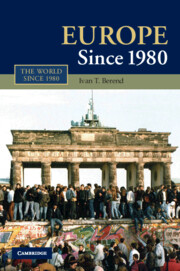Book contents
- Frontmatter
- Contents
- List of Illustrations
- List of Tables
- Acknowledgements
- Introduction
- 1 Europe Approaches the 1980s: The Dual Crises (1968–80)
- 2 The End of “Two Europes” and European Integration
- 3 The New Cultural and Political Setting
- 4 The Economic Response to Globalization; Recovery and Growth; the Integration of Eastern and Western Europe
- 5 Dramatic Demographic Changes, Consumerism, and the Welfare State
- Epilogue: Quo Vadis Europa?
- Bibliography
- Index
Epilogue: Quo Vadis Europa?
Published online by Cambridge University Press: 05 June 2012
- Frontmatter
- Contents
- List of Illustrations
- List of Tables
- Acknowledgements
- Introduction
- 1 Europe Approaches the 1980s: The Dual Crises (1968–80)
- 2 The End of “Two Europes” and European Integration
- 3 The New Cultural and Political Setting
- 4 The Economic Response to Globalization; Recovery and Growth; the Integration of Eastern and Western Europe
- 5 Dramatic Demographic Changes, Consumerism, and the Welfare State
- Epilogue: Quo Vadis Europa?
- Bibliography
- Index
Summary
Black Prophecies – or the Rise of a European Superpower?
World War II destroyed and weakened most of Europe, and the Cold War soon divided the continent into two separate and hostile halves. The West needed American financial and military assistance to rebuild its economy and to secure itself from outside dangers. A third of a century later, however, Western Europe rose as an economic superpower and the cradle of the welfare state. Besides postwar prosperity and its successful adjustment to globalization after the shock of the 1970s, the most important factor of Europe's rise was its rapid integration process, the foundation and enlargement of the European Union.
However, frightening negative demographic trends accompanied and counterbalanced the main positive trends. Europe's population is decreasing and aging and the ratio of active to inactive people will be 50:50 in a few decades. Rapidly increasing immigrant labor is replacing the inadequate domestic labor force. Immigrant minorities, mostly from non-European Muslim cultures, are rapidly increasing. Integration or assimilation is painfully slow, or non-existent. A part of the immigrant population, especially the illegal ones, form a new underclass. Anti-immigrant hostility and intolerance are fueling extreme right-wing political trends. The minority question became a source of explosive tension on the continent. Quo vadis Europa in the twentyfirst century? What will take over and dominate, positive or negative tendencies?
- Type
- Chapter
- Information
- Europe Since 1980 , pp. 286 - 302Publisher: Cambridge University PressPrint publication year: 2010

